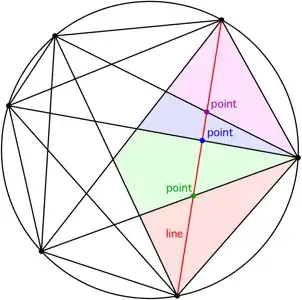Let's assume that no three lines intersect at the same point.
Consider what happens each time you add a line between two points. If it crosses $k$ other lines, it splits $k+1$ regions into two, thereby adding $k+1$ regions. Therefore, when a line is added, it can be considered to be adding $1$ region for the line and $1$ region for each point of intersection:
$\hspace{4.5cm}$ $$
\text{Regions Split by a Line}\atop\text{Each Region is Paired with a Line or Point of Intersection}
$$
Thus, we just need to count $1$ for the original region inside the circle, and add the number of lines, $\binom{N}{2}$, and the number of intersections, $\binom{N}{4}$.
$$
\text{Regions Split by a Line}\atop\text{Each Region is Paired with a Line or Point of Intersection}
$$
Thus, we just need to count $1$ for the original region inside the circle, and add the number of lines, $\binom{N}{2}$, and the number of intersections, $\binom{N}{4}$.
Thus, there are $\binom{N}{4}+\binom{N}{2}+\binom{N}{0}$ regions.
Counting Lines and their Intersections
Note that given $N$ points on the circle, each pair of points yields a line, thus the number of lines connecting the points is $\binom{N}{2}$. For each set of $4$ points, there is a unique intersection of two lines, an "X in a quadrilateral" arrangement. Thus, the number of interior line intersections is $\binom{N}{4}$.
Non-Sequitur:
This is often given as an example of what happens if you attempt to guess a sequence from the first few terms since this sequence starts with
$$
1,2,4,8,16,\dots
$$
but the next term is $31$.
Why:
The reason for the initial similarity of $\binom{n}{4\vphantom{0}}{+}\binom{n}{2\vphantom{0}}{+}\binom{n}{0}$ to the geometric progression is that
$$
\sum_{k=0}^\infty\binom{n}{k}=(1+1)^n=2^n\tag{1}
$$
and
$$
\sum_{k=0}^\infty(-1)^k\binom{n}{k}=(1-1)^n=0^n\tag{2}
$$
For $n>0$, adding $(1)$ and $(2)$ and dividing by $2$ gives
$$
\sum_{k=0}^\infty\binom{n}{2k}=2^{n-1}\tag{3}
$$
$\binom{n}{4\vphantom{0}}{+}\binom{n}{2\vphantom{0}}{+}\binom{n}{0}$ is the first three terms of $(3)$. The first time a non-zero term is left out of $(3)$ is when $n=6$, and that is when $\binom{n}{4\vphantom{0}}{+}\binom{n}{2\vphantom{0}}{+}\binom{n}{0}=31$.
 $$
\text{Regions Split by a Line}\atop\text{Each Region is Paired with a Line or Point of Intersection}
$$
Thus, we just need to count $1$ for the original region inside the circle, and add the number of lines, $\binom{N}{2}$, and the number of intersections, $\binom{N}{4}$.
$$
\text{Regions Split by a Line}\atop\text{Each Region is Paired with a Line or Point of Intersection}
$$
Thus, we just need to count $1$ for the original region inside the circle, and add the number of lines, $\binom{N}{2}$, and the number of intersections, $\binom{N}{4}$.